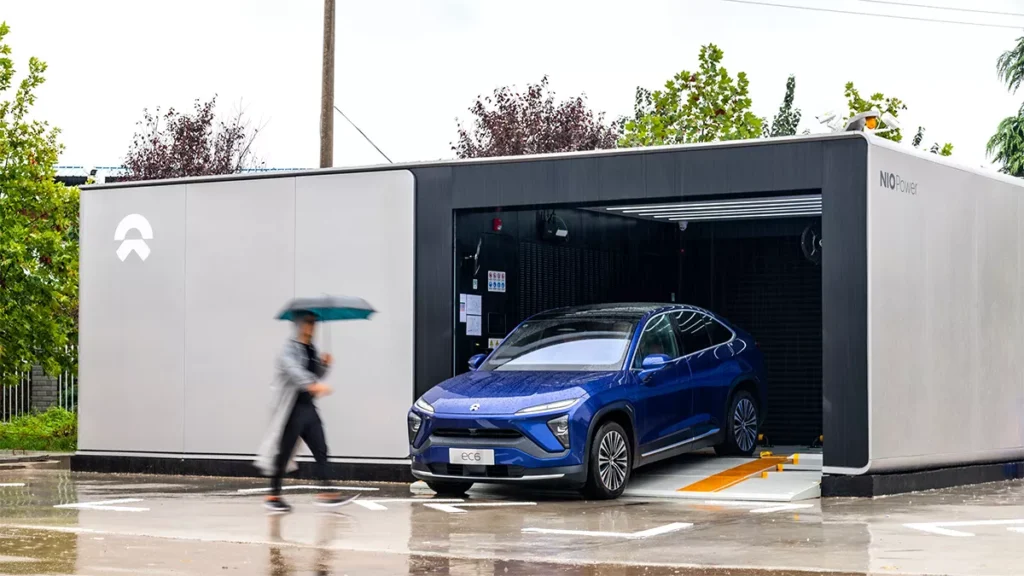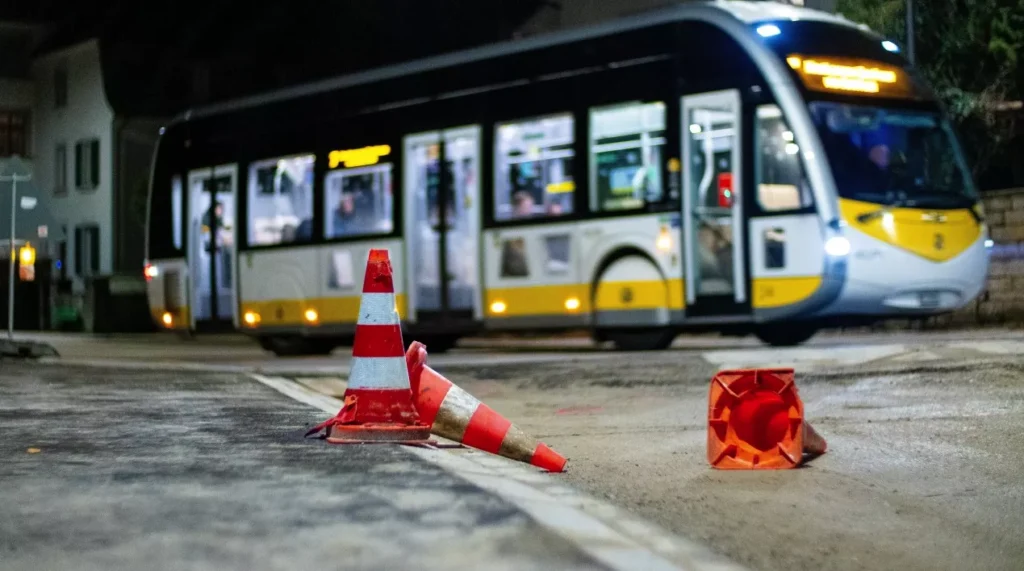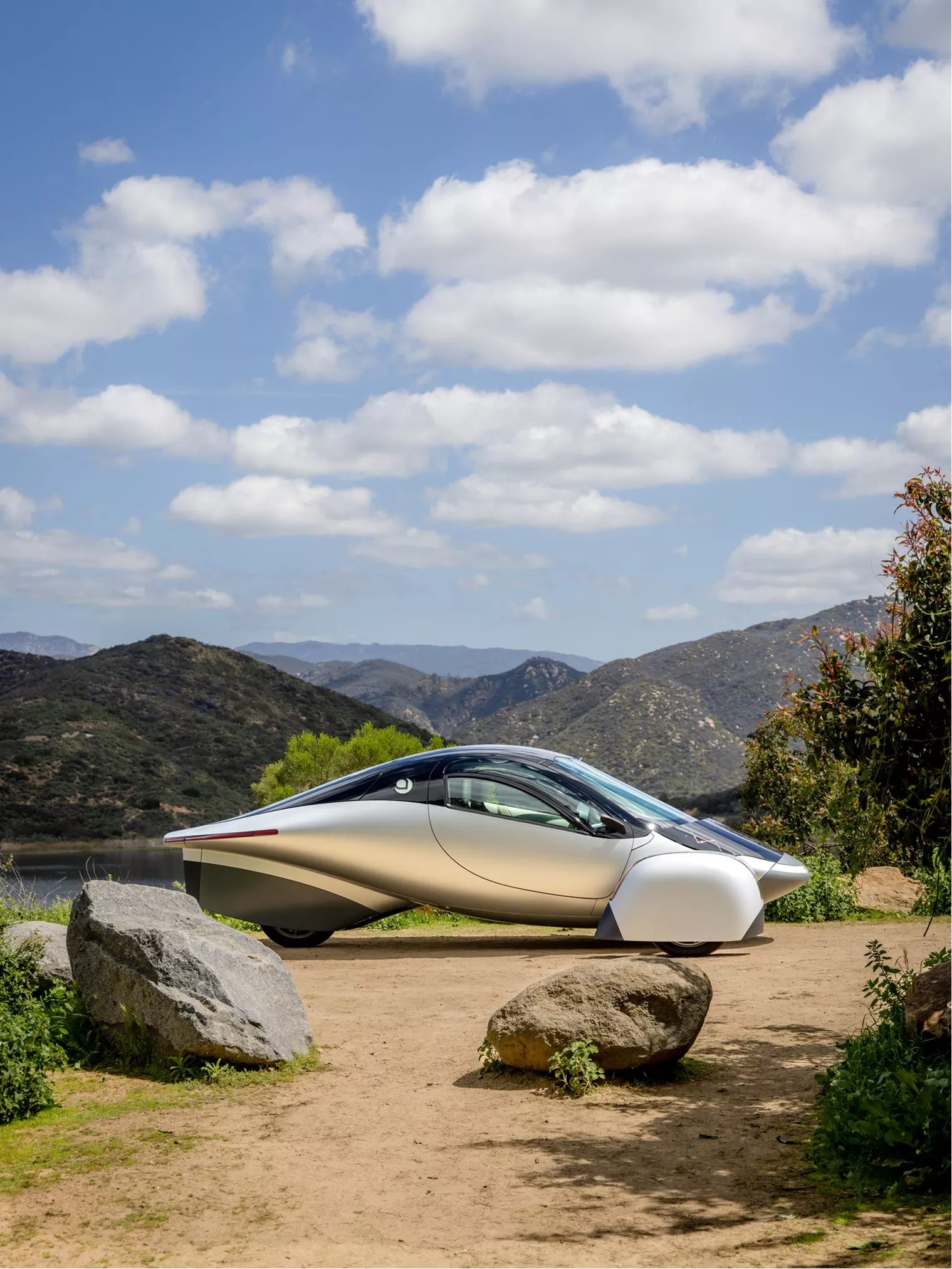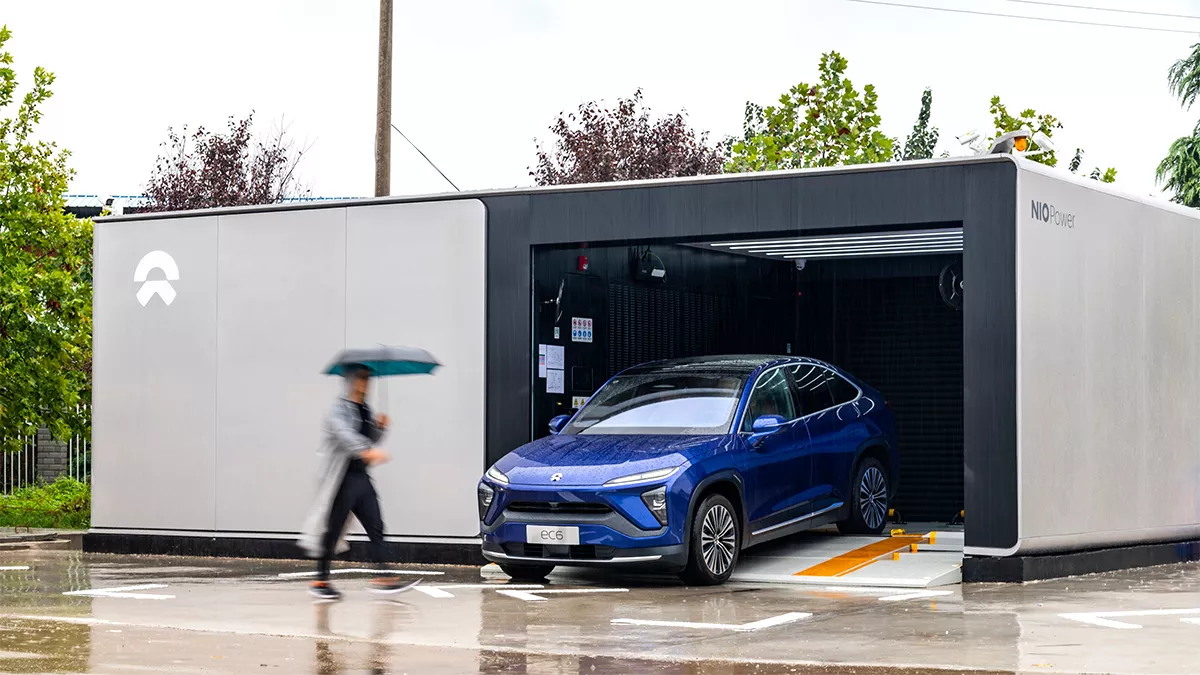










From EVs and batteries to autonomous vehicles and urban transport, we cover what actually matters. Delivered to your inbox weekly.

Battery swapping is back in the spotlight — and this time, it might actually stick.
While the rest of the EV world waits around for charging times to shrink, companies like NIO, Gogoro, and Ample are building a different future: one where you don’t charge your EV — you just swap the battery and go.
It’s fast. It’s clean. And in the right conditions, it beats charging at its own game.
But can battery swapping scale beyond China’s borders? Will it ever work for mainstream drivers, or is it destined to remain a niche fix?
Let’s break it down.
No cables. No waiting. No 45-minute “fast” charging sessions.
Battery swapping flips the script: instead of plugging in your EV and standing around, you roll into a station, your depleted battery gets yanked out by a robotic arm, a fresh one slides in — and you’re back on the road in under 5 minutes.
It’s like a pit stop, but for EVs.
🔄 Gogoro’s model (Taiwan) → Riders pull up to a compact kiosk, pop the battery out of their scooter, swap it with a fully charged one, and ride off. Entire process? 30 seconds. The network already handles over 400,000 swaps per day.
🏁 NIO’s model (China) → You drive into a fully automated station, stay in the car, and let the robots do their thing. In under 3 minutes, the system removes your battery, installs a new one, and runs diagnostics — all without human hands.
Batteries are modular and standardized within each brand’s ecosystem, so every swap is seamless. Think vending machine, but for 600 kg battery packs.
It’s fast. It’s clean. And in cities where space is tight and time is money, you can just imagine the scale of the impact.
If there’s a gold standard for battery swapping, NIO set it.
Since launching its first Power Swap Station in 2018, NIO has built a network of over 3,000 stations across China. And these are fully automated hubs that can complete a swap in under 3 minutes, no driver exit required. As of early 2025, NIO clocks in at over 98,000 swaps per day.
But here’s the real innovation — battery-as-a-Service (BaaS).
NIO separated battery ownership from the vehicle itself. That slashed the upfront price of its EVs by up to ¥70,000 ($9,600) and let users pay a monthly fee instead — currently starting around ¥980 ($135).
The benefits stack up:
🔄 No battery degradation worries — you always get a fresh pack.
⚡ Faster than charging, more consistent than public chargers.
📈 Better residual values for vehicles.
Customers are buying in. By late 2024, NIO reported that over 70% of new buyers opted for the BaaS model. And with plans to hit over 4,000 stations globally by 2025, it’s clear NIO’s not just selling cars — it’s selling infrastructure.
The question isn’t if battery swapping works. It’s how long until others catch up.

Taiwan runs on Gogoro.
With over 600,000 riders, Gogoro has turned battery swapping for two-wheelers into an urban utility. Its network powers more than 400,000 swaps per day — that’s a swap every 0.2 seconds.
At the heart of it all? A grid of 13,000+ GoStations and a fleet of 1.4 million smart batteries.
The formula is simple. Ride, swap, go. No downtime. No charging cables. Just pop in at a nearby kiosk, swap your battery in seconds, and you’re back in motion.
This isn’t a niche experiment. It’s mainstream mobility, backed by major players like Yamaha and Hero MotoCorp, both of whom are now integrating Gogoro’s tech into their own scooters. Gogoro has already expanded into India, China, South Korea, and Israel, making it the biggest battery-swapping player in the world.
The takeaway? When cities are dense, traffic is wild, and speed matters — swapping wins. And Gogoro’s not just building a product. It’s building the grid.

Ample isn’t trying to reinvent the EV. It’s reinventing how we fuel it.
Instead of building new cars, Ample builds modular battery kits that retrofit into existing EV models — no redesigns, no proprietary hardware. The goal? Turn any EV into a swappable one. And do it fast.
Their focus? Fleets. In San Francisco, Ample partnered with Uber to launch fully automated swap stations that deliver a full charge in under 5 minutes. Drivers save time, avoid peak charging costs, and stay on the road longer — a win-win for uptime and margins.
Ample is now scaling across Japan and Spain, backed by investments from ENEA, Shell Ventures, and fleet operators who are tired of range anxiety and charging bottlenecks.
It’s quiet. It’s robotic. It works while you sit in the car. For logistics, ride-hail, and urban fleets that live or die on availability, Ample is a competitive edge.

In cities where real estate is tight, driving hours are long, and speed is money, swapping has become a smart, scalable alternative to plug-in charging.
Here’s why it’s catching fire.
Time is money — and nobody wants to wait 40 minutes for a charge.
Battery swapping cuts downtime to nearly zero. NIO’s Power Swap stations complete a fully automated battery swap in under 3 minutes, with no driver intervention. That’s faster than filling a tank.
In time-critical sectors — think ride-hailing, last-mile delivery, or intercity taxi — every saved minute matters.
The battery can account for 30–40% of an EV’s cost. Battery-as-a-Service removes that burden.
BaaS also future-proofs the car. When a better battery is available, users can swap into it — no trade-in, no depreciation hit.
Charging habits vary. And that’s proving to be a problem.
In the plug-in model, battery health depends heavily on how carefully (or recklessly) the owner charges it. Overcharging, heat exposure, and deep discharges all degrade performance over time.
Swapping centralizes that risk:
NIO has reported that their managed batteries degrade slower than traditional EV batteries, and Gogoro’s smart lockers track every single battery’s usage, temperature, and charge cycle.
Let’s be real: most people in cities can’t install a home charger.
Battery swapping removes that constraint.
For scooter riders in dense megacities, charging was never viable. Swapping works.
Fleets don’t have time for charging queues or long waits.
That’s why Ample is targeting the commercial market with a modular approach:
Ample has partnered with Uber, ENNEOS (Japan), and Repsol (Spain) to bring this tech to ride-hailing and delivery vehicles in high-utilization urban zones.
Plus, modularity means scaling quickly. Fleets don’t need to redesign vehicles from scratch — just install a kit and go.
Swapping is a legitimate charging alternative built for density, scale, and speed. And in markets where:
…it’s already outperforming plug-in charging in key metrics: turnaround time, battery lifecycle, cost efficiency, and urban fit.
Battery swapping may not replace plug-in charging everywhere. But in the places that matter most — cities, fleets, and fast-moving economies — it’s already leading the charge.
Swapping might sound like a no-brainer to you. But if it really were, we’d see swapping stations on every corner by now.
Here’s what’s still holding it back.
Building a swap station isn’t like installing a Level 2 charger in your garage. NIO’s Power Swap stations reportedly cost $500K–$750K each to build and maintain. That’s before factoring in the cost of stocking dozens of idle batteries on-site.
Without massive upfront capital or government subsidies, most startups can’t scale — and most automakers won’t even try.
There’s no universal battery shape, size, or mounting system. NIO batteries won’t fit a BYD. Gogoro batteries only work in Gogoro-powered scooters. That means:
Until the industry agrees on a standard, each new player builds their own walled garden.
Letting a robot yank the battery out of your brand-new EV feels weird. Add to that:
And you’ve got a trust gap that takes millions of flawless swaps to close. (Even NIO, with 30M+ swaps under its belt, still faces this in new markets.)
Most EVs are not built for swapping. Their battery packs are massive, integrated into the chassis, and not designed for quick ejection. Swapping works best when:
That’s why it’s easier to launch in places like Taiwan or with fleets that can standardize quickly.
Plug-in charging already has a head start. The global EV charging market is worth over $30B and growing fast. Governments are pouring billions into public charger rollouts — not swap stations.
To win, swapping needs to:
That’s a tall order — but in the right markets, it’s already happening.
Battery swapping isn’t going anywhere, but we must understand that it’s not a silver bullet either. The next wave of adoptions hugely depends on solving these frictions points. And how fast we can do it.
Let’s kill the myth: swapping isn’t here to replace charging — it’s here to complement it.
Different tools, different jobs.
Here’s how they stack up:
Swapping wins — hands down.
A full battery swap takes under 5 minutes (NIO clocks in at 3). That’s faster than most gas stops.
Charging, even with DC fast chargers, takes 15–45 minutes, depending on the vehicle.
For time-critical ops (taxis, delivery fleets, ride-hailing), every minute saved is money made.
Charging wins at scale — eventually.
Home and depot chargers are cheap to install and cheap to run. Public charging? Less so.
Swapping comes with high infrastructure costs, but with BaaS models, users avoid battery ownership, reducing upfront EV prices by $10K or more.
Fleets and early adopters love the flexibility — but someone’s footing the CapEx bill.
Depends on who you are.
Charging is unbeatable for home or overnight use.
Swapping shines in urban areas, dense city grids, or for commercial vehicles on tight schedules.
Need range in a hurry? Swapping.
Swapping is smarter — on paper.
Operators control charge cycles, cool batteries properly, and optimize for grid demand, extending battery life and easing grid stress.
Charging is decentralized and less predictable. Peaks can hammer local grids without proper load balancing.
Swapping plays nice with energy management. But it only works at scale.
Charging wins — for now.
Most EVs today use universal charging standards (CCS, Type 2, etc.).
Swapping? Still a closed ecosystem. NIO stations serve NIO cars. Gogoro batteries power Gogoro bikes. That’s it.
Until standards emerge, swapping will be limited to players who control the full stack.
Swapping feels like magic when it works.
No cables. No waiting. No planning. Just in, out, drive.
Charging is everywhere — but varies in speed, reliability, and pricing. One bad charger ruins your day.
Swapping needs infrastructure. Charging needs consistency. Both have UX gaps.
The verdict?
Battery swapping wins on speed, battery health, and fleet logic.
Charging wins on accessibility, scale, and standardization.
The goal isn’t to pick a winner. The goal is to match the tech to the need. The cities, fleets, and automakers who figure this out first? They’re the ones who’ll lead.
It’s not a fringe experiment anymore. Battery swapping is scaling fast in the East — and starting to catch fire in the West. Governments are backing it. Startups are betting on it. And the economics? They’re finally lining up.
Here’s what that wave looks like.
China is already leading the charge.
And NIO’s not alone — Geely, Aulton, and others are expanding aggressively.
China aims to exceed 16,000 battery swap stations by this year, with companies like CATL and Sinopec planning to build more than 10,000 new stations as a part of their strategic partnerships.
The numbers are just 🤯
India’s swapping strategy is laser-focused on e-scooters, rickshaws, and bikes — and it’s working.
According to the Trade Promotion Council of India, the country’s battery swapping market could hit $61.57 million by 2030 — up from just $10.2 million in 2023.
Gogoro made battery swapping a way of life in Taiwan.
For two-wheelers, it’s proof that swapping can become default.
In Rwanda and Kenya, Ampersand is rewriting EV adoption for motorcycle taxis.
A different model, same story — convenience wins.
Europe is dabbling with pilots, mostly through public-private consortiums.
In the U.S., it’s all about B2B:
Still early days — but the infrastructure is quietly being tested behind the scenes.
Battery swapping is no longer a fringe experiment — it’s becoming a serious player in the EV ecosystem.
According to Grand View Research, the global battery leasing and swapping market hit $2.9 billion in 2023. By 2030? It’s expected to explode to $42.6 billion, riding a jaw-dropping 46.9% CAGR.
China and Taiwan have proven the model at scale. Now, the question is no longer if swapping can work — it’s where it will work next.
📈 Tipping point by 2027
Battery swapping and fast charging are racing toward a shakeout. By 2027, BloombergNEF predicts cost parity between EVs and gas vehicles in many markets — and that’s when adoption goes vertical.
🔋 Battery tech goes next-gen
Solid-state, faster swaps, modular packs — battery R&D is heating up. Expect smaller, lighter, longer-lasting batteries built for flexibility, not just range.
⚡ Charging vs. swapping: The real race
It’s not about picking a winner — it’s about solving for the use case. Swapping dominates urban fleets and dense cities. Charging holds the edge on highways. Both will expand, fast.
🏛️ Governments get serious
Regulators are stepping in with deadlines and dollars. India’s FAME scheme, China’s EV mandates, the EU’s Green Deal — all of them point to one thing: fossil fleets are on borrowed time.
🤝 Collaboration will define winners
Battery tech, vehicle makers, energy providers — the walls are coming down. Watch for unlikely partnerships, like OEMs teaming up with energy giants to scale battery-as-a-service models.
One thing’s clear: the future isn’t plug vs. swap. It’s fast, flexible, and built for movement.
It’s fast. It’s proven. And in the right markets, it’s already winning.
Battery swapping solves real-world pain points — from range anxiety to charging downtime — especially in dense cities, high-mileage fleets, and places where plugs just can’t keep up.
Is it perfect? No. Standardization, cost, and trust still stand in the way. But dismissing swapping as a niche solution? That’s yesterday’s thinking.
The smart bet isn’t one vs. the other. It’s building the right tools for the job.
So here’s the question: will your EV future be plugged in… or powered up in 60 seconds flat?